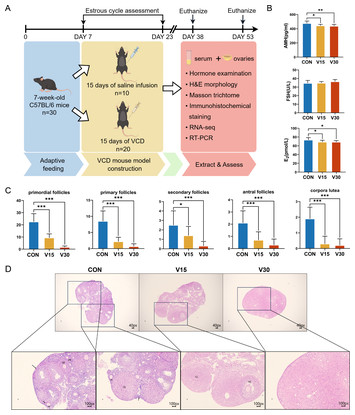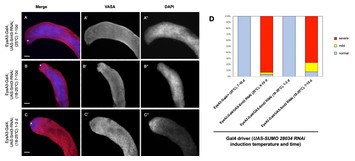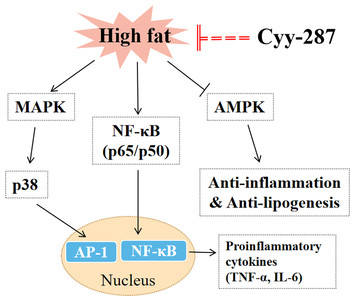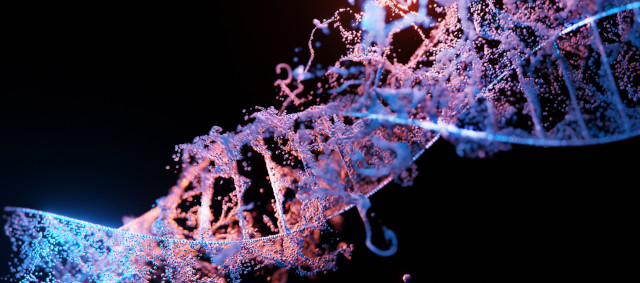PeerJ Section
Biochemistry, Biophysics and Molecular Biology
Welcome to your community’s home at PeerJ. Sections are community led and exemplify a research community’s shared values, norms and interests.
The citation average is 6.4 (view impact metrics).
54,684 Followers
Section Highlights
View all Biochemistry, Biophysics and Molecular Biology articles 

18 April 2024
S100A8/9 modulates perturbation and glycolysis of macrophages in allergic asthma mice
"This research investigates the role of S100A8 and S100A9 molecules in allergic asthma, highlighting their impact on macrophage behavior and glycolysis through the (likely) TLR4/MyD88/NF-κB signaling pathway. The study demonstrates that S100A8 and S100A9 promote inflammatory responses, macrophage polarization, and glycolysis, contributing to asthma pathogenesis. Conversely, inhibiting these molecules shows promising therapeutic potential, as evidenced by improved respiratory function and reduced inflammation in mouse models. These findings offer valuable insights into the immune dysregulation and metabolic alterations associated with allergic asthma, suggesting new avenues for targeted therapeutic interventions to alleviate asthma symptoms and improve patient outcomes."
 Sonia Oliveira, Handling Editor
Sonia Oliveira, Handling Editor
 Sonia Oliveira, Handling Editor
Sonia Oliveira, Handling Editor

18 April 2024
Transcriptome analysis during 4-vinylcyclohexene diepoxide exposure-induced premature ovarian insufficiency in mice
"If VCD is used in a poorly ventilated workspace, it could be inhaled as dust or vapor. or via skin by Direct contact with VCD through contaminated clothing or surfaces. this work It confirms previous findings of VCD's impact on ovarian function, Shows potential differences in damage depending on the duration of exposure (day 15 vs day 30), Identifies potential mechanisms like steroid hormone synthesis and DNA repair as areas for future research on treatment strategies. VCD-induced POI specifically reduces the number of eggs available for ovulation, impacting fertility. this work sheds light on a specific environmental risk factor for POI and potentially offers clues for future research on POI mechanisms."
 Sonia Oliveira, Handling Editor
Sonia Oliveira, Handling Editor
 Sonia Oliveira, Handling Editor
Sonia Oliveira, Handling Editor

9 April 2024
The role of echinacoside-based cross-linker nanoparticles in the treatment of osteoporosis
"This study on the therapeutic effects of cross-linker (CL)-ECH nanoparticles in treating osteoporosis is important due to several key reasons. Firstly, the current drugs used for osteoporosis treatment often come with toxic side effects, highlighting the urgent need for safer and more effective alternatives. The utilization of Echinacoside (ECH) as a natural small molecule drug and the development of CL-ECH nanoparticles present a novel and promising approach to address this issue. The research exploring the antioxidant effects of CL-ECH nanoparticles on bone marrow-derived macrophages (BMDMs) and their impact on bone marrow stromal cells (BMSCs) provide valuable insights into the mechanisms underlying osteoporosis treatment. The findings of this study, particularly the suppression of oxidative stress in BMDMs and the improvement in bone trabecular loss in an ovariectomized mouse model, demonstrate the potential of CL-ECH nanoparticles as a more targeted and efficient therapeutic intervention for osteoporosis. Furthermore, the identification of NRF-2 nuclear translocation as a key pathway affected by CL-ECH nanoparticles, leading to the downregulation of NF-κB expression and inhibition of osteoclast production, contributes significantly to our understanding of the molecular mechanisms involved in bone resorption and osteoporosis progression. These insights have the potential to inform the development of a new generation of anti-bone resorption drugs with enhanced efficacy and reduced side effects. This article not only offers a promising alternative for osteoporosis treatment but also advances our knowledge of the pathophysiology of the disease. The potential impact of this research on the field lies in its contribution to the development of safer and more targeted therapeutic strategies for osteoporosis, ultimately benefitting patients by improving treatment outcomes and quality of life."
 Fanglin Guan, Handling Editor
Fanglin Guan, Handling Editor
 Fanglin Guan, Handling Editor
Fanglin Guan, Handling Editor

29 March 2024
Identification, validation and quantification of thymoquinone in conjunction with assessment of bioactive possessions and GC-MS profiling of pharmaceutically valuable crop Nigella (Nigella sativa L.) varieties
 Anshuman Singh, Handling Editor
Anshuman Singh, Handling Editor

28 March 2024
Identification of WRKY gene family in Dioscorea opposita Thunb. reveals that DoWRKY71 enhanced the tolerance to cold and ABA stress
"This is good piece of work and will enhance about our knowledge about the WRKY family and their role in abiotic stress tolerance."
 Kashmir Singh, Handling Editor
Kashmir Singh, Handling Editor
 Kashmir Singh, Handling Editor
Kashmir Singh, Handling Editor

27 March 2024
The clinical association of programmed death-1/PD-L1 axis, myeloid derived suppressor cells subsets and regulatory T cells in peripheral blood of stable COPD patients
 Ramcés Falfán-Valencia, Handling Editor
Ramcés Falfán-Valencia, Handling Editor

14 March 2024
Chigno/CG11180 and SUMO are Chinmo-interacting proteins with a role in Drosophila testes somatic support cells
"This paper identifies new players in Drosphila testes stem cell differentiation by identifying Chimno interacting partners."
 Judith Yanowitz, Handling Editor
Judith Yanowitz, Handling Editor
 Judith Yanowitz, Handling Editor
Judith Yanowitz, Handling Editor

1 March 2024
Bimetallic nanoparticles and biochar produced by Adansonia Digitata shell and their effect against tomato pathogenic fungi
"The manuscript addresses a relevant issue, the search for new compounds with antifungal activities."
 Héctor Mora-Montes, Handling Editor
Héctor Mora-Montes, Handling Editor
 Héctor Mora-Montes, Handling Editor
Héctor Mora-Montes, Handling Editor

29 February 2024
Molecular cloning and characterization of farnesyl diphosphate synthase from Rosa rugosa Thunb associated with salinity stress
 Mahmood-ur- Rahman, Handling Editor
Mahmood-ur- Rahman, Handling Editor

29 February 2024
Cyy-287, a novel pyrimidine-2,4-diamine derivative, efficiently mitigates inflammatory responses, fibrosis, and lipid synthesis in obesity-induced cardiac and hepatic dysfunction
"The discussed work highlights the global concern of obesity as a public health epidemic, emphasizing its association with chronic inflammation and related diseases. The research focuses on a novel compound, Cyy-287, reporting on its inhibitory effect on high-fat diet-induced inflammation and tissue damage in mice. The study delves into the molecular mechanisms, revealing that Cyy-287 acts by inhibiting NF-κB and MAPK signaling pathways, activating AMPK signaling, and suppressing liver lipid synthesis. The findings suggest that Cyy-287 has therapeutic potential for mitigating obesity-induced cardiac and hepatic damage. The limitations are acknowledged, and future studies are proposed to deepen the understanding of Cyy-287's mechanisms and effects. The work is significant for researchers and clinicians interested in developing treatments for obesity-related complications."
 Sonia Oliveira, Handling Editor
Sonia Oliveira, Handling Editor
 Sonia Oliveira, Handling Editor
Sonia Oliveira, Handling Editor
Collections
View all 
Biological Clocks and Social Organization

PeerJ at 10 - our first 30 papers.

Advances in Illuminating the Druggable Genome

Food Safety Issues During- and Post-Pandemic/Epidemic Situations; Production, Packaging, Storage, and Analysis Interventions

Pulsed Resources Impacts on Biological Processes: From Genes to Ecosystems

54,684 Followers


